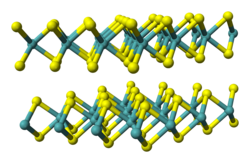 | |
| Names | |
|---|---|
| Other names Technetium disulphide | |
| Identifiers | |
3D model (JSmol) | |
| ChemSpider | |
PubChem CID | |
| |
| |
| Properties | |
| S2Tc | |
| Molar mass | 162 g·mol−1 |
| Structure | |
| trigonal | |
| Related compounds | |
Related compounds | Molybdenum disulfide |
Except where otherwise noted, data are given for materials in their standard state (at 25 °C [77 °F], 100 kPa). | |
Technetium disulphide is a binary inorganic chemical compound of technetium metal and sulfur with the chemical formula TcS2. [1] [2] [3] [4]